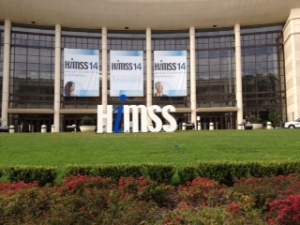HIMSS 2014: Top five things you may have missed
February 27, 2014

By Loren Bonner and Lauren Dubinsky
HIMSS wraps up today in Orlando, Fla. Each year, the show increases not only in attendance, but also in square footage. Total registration figures stood at 38,828, making it the largest HIMSS conference to date. The second largest was in Las Vegas in 2012 with 36,506. On the show floor, there were 1,233 exhibitors — a 7 percent increase from last year — with more than 400 exhibiting for the first time. Many vendor solutions were aimed at bringing all of a patient's information together with the idea that this will improve care coordination and also move health care in the direction of eventually being able to make treatment truly personalized and even predictive. While health IT is advancing at a rapid pace, many providers and facilities are less concerned about keeping up with the latest and greatest. Instead, they want to be ready for two looming regulatory hurdles later this year — ICD-10 and meaningful use stage 2.
These are our top observations from HIMSS14, but if you saw something that caught your eye that we missed, drop us a line in the comments section below.
1. Meeting new policy mandates. This year is a big year for the health care industry — meaningful use stage 2 (MU2) starts and Oct. 1 marks the deadline for ICD-10. The 25th Annual HIMSS Leadership Survey, revealed during the show, found that three-quarters of respondents believe they will be ready for MU2 and 92 percent say they will meet the ICD-10 deadline.
Many vendors have created products and services to help make the transition go smoothly. Because of MU2, there is an increasing demand for hospitals and imaging centers to make data available in all electronic health records (EHRs) in their provider communities. But integrating with multiple EHRs is expensive and time-consuming.
Merge Healthcare's iConnect Network, which was on display at HIMSS14, helps providers meet regulatory requirements without the need to build expensive point-to-point Health Level 7 interfaces.
M*Modal, the transcription and speech recognition company, is using technology and services to help organizations transition to the new code set. "Fluency One brings together an integrated transcription service, speech technology, coding services, and clinical feedback solution on a single platform, by a single vendor," said Jolie Rollins, director of solution sales at M*Modal. She added that customers are "visibly relaxed" when they take over for a short amount of time.
2. Making peace with a lost return on investment. New findings from HIMSS show that hospitals that invested in EHR systems anticipate less than 2 million back for an investment that ranged from $250,000 to $999,999 to meet meaningful use stage 1 requirements. Even more respondents expect an even smaller ROI for stage 2.
|
|
|
You Must Be Logged In To Post A Comment
|
